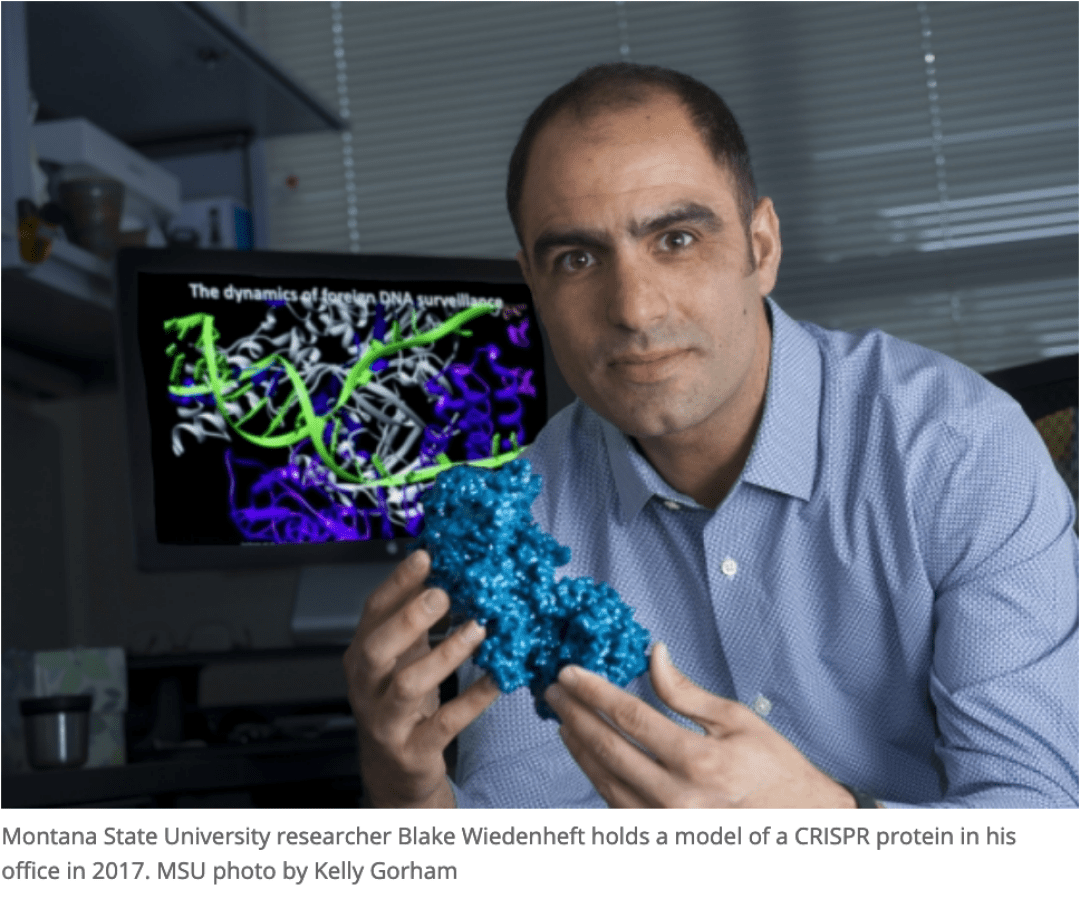MSU researcher secures $2.5 million grant from National Institutes of Health
Tuesday Apr. 28th, 2020

Montana State University researcher Blake Wiedenheft is a recognized expert in one of today's hottest science fields, so it's natural to wonder what discoveries may be in store now that he received a $2.5 million grant from the National Institutes of Health earlier this year.
And because the NIH's Maximizing Investigators' Research Award is designed to provide flexibility to delve deeply into research that could generate breakthroughs, Wiedenheft himself is looking forward to seeing where the five-year funding will lead in his study of the complex interactions between bacteria and the viruses that attack them, with potential applications for treating COVID-19 and a wide range of other diseases.
"An ideal outcome would be stumbling on something entirely unexpected," said Wiedenheft, associate professor in the Department of Microbiology and Immunology in MSU's College of Agriculture. "This grant really provides a new dimension of intellectual freedom for pursuing ideas as they evolve."
"Dr. Wiedenheft’s award is well-deserved and highly prestigious," said Jason Carter, MSU's vice president for research, economic development and graduate education. "These MIRA grants are indicative of sustained, high-impact research by accomplished scientists."
The grant will allow Wiedenheft to significantly expand his lab's capacity, adding up to six doctoral students, four postdoctoral researchers and a lab technician. Wiedenheft has made major contributions to the field in recent years, including high-profile papers in Science, Nature and other journals about CRISPR, the bacteria immune system that wields sophisticated molecules to grab and slice strands of invading viral DNA to render them harmless.
The grant "is an impressive achievement for Blake, and it represents tremendous recognition within a very competitive field of science," said Montana University System Regents Professor Mark Jutila, head of the microbiology and immunology department. "His efforts in the study of CRISPR have had major impacts in the field as well as at MSU, in terms of mentoring and training students in the lab and teaching in the classroom."
Although CRISPR is often used as a general term for CRISPR-Cas9 and a few other proteins that have been repurposed for curing genetic disease, those CRISPR systems "represent a very small fraction of bacterial immune systems found in nature," Wiedenheft said. "CRISPRs are very diverse," and many — perhaps most — haven't been studied in detail, he said.
The NIH grant will allow Wiedenheft's team to explore the frontier of CRISPRs and other immune systems in bacteria, which, scientists are increasingly finding, in many ways resemble those of more complex organisms, including humans.
"Some of these immune systems are incredibly complicated," Wiedenheft said. "To understand how they work and which parts are most important, we look to the viruses for help." That's because viruses have often evolved elegant mechanisms to thwart the bacterial defense, he explained. In one recent study, Wiedenheft showed that a virus produced a protein molecule — called an anti-CRISPR — that mimics the CRISPR's alert system, creating a decoy that distracts the bacteria's response.
Peering inside of bacteria with an extremely powerful microscope to see CRISPR molecules is a bit like encountering a complex machine like a car and trying to figure out how it works, Wiedenheft said. Because viral anti-CRISPRs target parts of the “car” that are important or vulnerable, "a virus can point you directly to the ignition switch, or the gas pedal or the steering wheel," he said.
"Viruses can teach us about the immune systems we're studying, and sometimes even point us to new immune systems that we didn’t even know about," Wiedenheft said. "We anticipate that anti-CRISPRs, like CRISPRs themselves, are incredibly diverse. By understanding that diversity, we think we'll gain a much better understanding of how these immune systems work."
Recent trials with human patients have shown success with using CRISPR-Cas9 to treat and potentially cure sickle cell disease, a serious disorder affecting millions of people around the world. The CRISPR treatment involves surgically correcting a genetic defect by cutting the DNA and repairing it in a way that restores gene function. Diseases like sickle cell, Beta thalassemia and other blood diseases are the easiest to treat because the cells in blood are relatively easy to access. But many labs, including Wiedenheft's, are working to develop new treatment methods that direct the CRISPR-Cas9 treatment to specific cells within the body, according to Wiedenheft.
In responding to the coronavirus pandemic, some scientists have also repurposed other CRISPR proteins, Cas12 and Cas13, to rapidly diagnose COVID-19 in experimental medical tests — yet another indication of the far-reaching potential of precisely mapping CRISPRs and developing an understanding of how they might be applied, according to Wiedenheft.
Wiedenheft is the second person at MSU to receive the NIH's Maximizing Investigators' Research Award. Last year, Joan Broderick, professor in the Department of Chemistry and Biochemistry in MSU's College of Letters and Science, won the five-year grant in the amount of $1.77 million for research on a large family of enzymes called radical SAMs.
| Tweet |